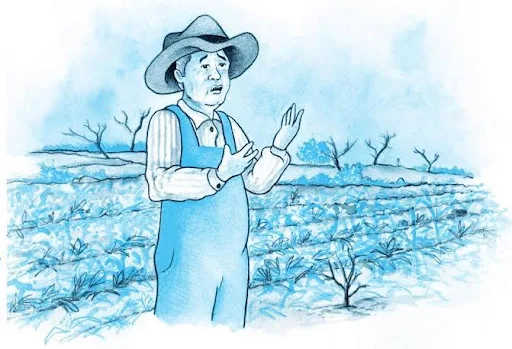Prose: "A Letter to God"
Summary:
"A Letter to God" by G.L. Fuentes narrates the story of Lencho, a farmer who relies entirely on his crops for sustenance. Anticipating a good harvest, Lencho becomes disheartened when a severe hailstorm destroys his fields. In his deep faith, he writes a letter to God seeking 100 pesos to replant his crops. Moved by his faith, the postmaster collects money from his colleagues, but they can gather only 70 pesos. Lencho, upon receiving the money, becomes angry, believing that the postal employees stole the remaining amount, and writes another letter to God, urging Him not to send the money through the mail, as he thinks the postal staff are thieves.
Exercise Solutions:
1. What did Lencho hope for?
Lencho hoped for a good rain to ensure a bountiful harvest.
2. Why did Lencho say the raindrops were like 'new coins'?
He compared the raindrops to new coins because they promised a good harvest, symbolizing wealth and prosperity.
3. How did the rain change? What happened to Lencho's fields?
The rain turned into a hailstorm, which devastated Lencho's crops, leaving him without any prospects for the harvest.
4. Who or what did Lencho have faith in? What did he do?
Lencho had unwavering faith in God. He wrote a letter to God requesting 100 pesos to reseed his fields.
5. Who read the letter? What did the postmaster do then?
The postmaster read Lencho's letter. Touched by his faith, he decided to collect money from his colleagues to help Lencho.
6. Was Lencho surprised to find a letter for him with money in it?
No, Lencho was not surprised because he had absolute faith that God would respond to his plea.
7. What made him angry?
Lencho became angry when he counted the money and found only 70 pesos instead of the 100 he had requested, leading him to believe that the postal employees had taken the rest.
Poem: "Dust of Snow"
Summary:
"Dust of Snow" by Robert Frost depicts a simple moment where the speaker's mood is uplifted when a crow shakes down snow from a hemlock tree onto him. This small act of nature brings about a profound change in the speaker's mood, highlighting how trivial events can have significant positive effects.
Exercise Solutions:
1. What is a 'dust of snow'? What does the poet say has changed his mood? How has the poet's mood changed?
A 'dust of snow' refers to fine particles of snow. The poet's mood changed when the crow shook the snow onto him, lifting his spirits and making him feel more positive.
2. How does Frost present nature in this poem?
Frost presents nature as a source of joy and positivity, capable of uplifting one's mood through simple, everyday events.
3. What do the 'crow' and 'hemlock' represent—joy or sorrow? What does the dust of snow represent?
Both the 'crow' and 'hemlock' are traditionally associated with sorrow. However, in the poem, they contribute to a positive experience, suggesting that elements linked to negativity can also bring joy. The 'dust of snow' represents a transformative moment that changes the poet's mood for the better.
Poem: "Fire and Ice"
Summary:
In "Fire and Ice," Robert Frost explores the potential end of the world through the symbols of fire and ice, representing desire and hatred, respectively. He reflects on how both emotions are powerful enough to lead to destruction, emphasizing the profound impact of human emotions on the world's fate.
Exercise Solutions:
1. According to the poet, what do 'fire' and 'ice' represent?
'Fire' represents intense desires, while 'ice' symbolizes hatred.
2. What is the rhyme scheme of the poem?
The rhyme scheme of the poem is ABA ABC BCB.
3. How does the poem convey the destructive potential of human emotions?
The poem suggests that both uncontrolled desires ('fire') and hatred ('ice') have t
he potential to cause significant destruction, possibly leading to the end of the world.
